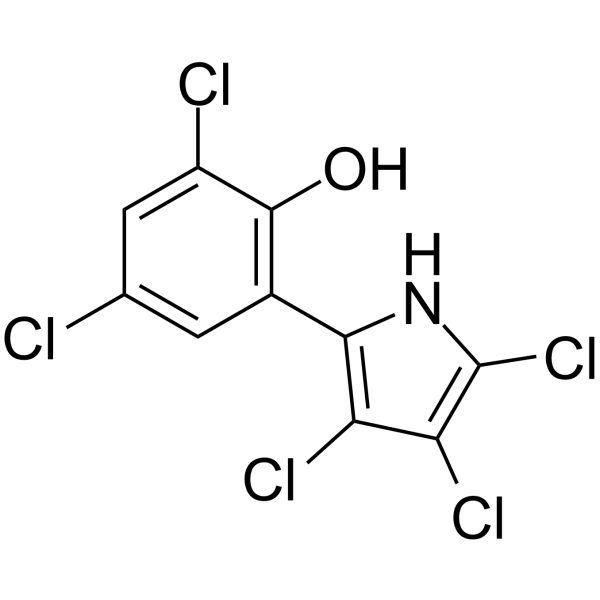Pentachloropseudilin (Synonyms: Antibiotic A 15104 Y; PClP) |
| Catalog No.GC63650 |
Pentachloropseudilin(항생제 A 15104 Y; PClP)은 가역적이고 알로스테릭한 Myo1s(1급 미오신) 억제제로 IC50 범위는 포유류 1급 미오신의 경우 1~5μM, 2급 및 5급의 경우 90μM 이상입니다. 미오신. Pentachloropseudilin은 TGF-β에 대한 IC50이 0.1~0.2μM인 형질전환 성장인자-β(TGF-β)-자극 신호전달의 강력한 억제제입니다.
Products are for research use only. Not for human use. We do not sell to patients.

Cas No.: 69640-38-6
Sample solution is provided at 25 µL, 10mM.
Pentachloropseudilin (Antibiotic A 15104 Y; PClP) is a reversible and allosteric potent inhibitor of Myo1s (class 1 myosins) with IC50s range from 1 to 5 μM for mammalian class-1 myosins and greater than 90 μM for class-2 and class-5 myosins. Pentachloropseudilin is a potent inhibitor of transforming growth factor-β (TGF-β)-stimulated signaling, with an IC50 of 0.1 to 0.2 μM for TGF-β[1][2].
Pentachloropseudilin (PClP) inhibits TGF-β-stimulated Smad2/3 phosphorylation and plasminogen activator inhibitor-1 (PAI-1) promoter activation with an IC50 of 0.1 μM in target cells (A549, HepG2, and Mv1Lu cells)[1].Pentachloropseudilin attenuates TGF-β-stimulated expression of vimentin, N-cadherin, and fibronectin and, thus, blocks TGF-β-induced epithelial to mesenchymal transition (EMT) in these cells. Pentachloropseudilin (0.05 to 1 μμ; 0-6 hours) pretreatment inhibits TGF-β-mediated (50 or 100 pM) increases in p-Smad2/3 expression to 47% (Mv1Lu) and 79% (A549), respectively[1]. Pentachloropseudilin (0.2 μM) suppresses TGF-β-stimulated cellular responses by attenuating cell-surface expression of the type II TGF-β receptor through accelerating caveolae-mediated internalization followed by primarily lysosome-dependent degradation of the receptor, as demonstrated by sucrose density gradient analysis and immune fluorescence staining[1].Pentachloropseudilin (200 μM; 24 hours) exhibits and altered cell viability in HUVECs[2].
[1]. Chinthalapudi K, et al. Mechanism and specificity of pentachloropseudilin-mediated inhibition of myosin motor activity. J Biol Chem. 2011;286(34):29700-29708.
[2]. Chung CL, et al. Pentachloropseudilin Inhibits Transforming Growth Factor-β (TGF-β) Activity by Accelerating Cell-Surface Type II TGF-β Receptor Turnover in Target Cells. Chembiochem. 2018;19(8):851-864.
[3]. Cota Teixeira S, et al. Pentachloropseudilin Impairs Angiogenesis by Disrupting the Actin Cytoskeleton, Integrin Trafficking and the Cell Cycle. Chembiochem. 2019;20(18):2390-2401.
Average Rating: 5 (Based on Reviews and 39 reference(s) in Google Scholar.)
GLPBIO products are for RESEARCH USE ONLY. Please make sure your review or question is research based.
Required fields are marked with *




















